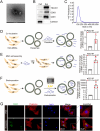Dual anti-angiogenic and anti-inflammatory action of tRNA-Cys-5-0007 in ocular vascular disease
- PMID: 38867291
- PMCID: PMC11167814
- DOI: 10.1186/s12967-024-05338-w
Dual anti-angiogenic and anti-inflammatory action of tRNA-Cys-5-0007 in ocular vascular disease
Abstract
Background: Intravitreal injections of angiogenesis inhibitors have proved efficacious in the majority of patients with ocular angiogenesis. However, one-fourth of all treated patients fail to derive benefits from intravitreal injections. tRNA-derived small RNA (tsRNA) emerges as a crucial class of non-coding RNA molecules, orchestrating key roles in the progression of human diseases by modulating multiple targets. Through our prior sequencing analyses and bioinformatics predictions, tRNA-Cys-5-0007 has shown as a potential regulator of ocular angiogenesis. This study endeavors to elucidate the precise role of tRNA-Cys-5-0007 in the context of ocular angiogenesis.
Methods: Quantitative reverse transcription PCR (qRT-PCR) assays were employed to detect tRNA-Cys-5-0007expression. EdU assays, sprouting assays, transwell assays, and Matrigel assays were conducted to elucidate the involvement of tRNA-Cys-5-0007 in endothelial angiogenic effects. STZ-induced diabetic model, OIR model, and laser-induced CNV model were utilized to replicate the pivotal features of ocular vascular diseases and evaluate the influence of tRNA-Cys-5-0007 on ocular angiogenesis and inflammatory responses. Bioinformatics analysis, luciferase activity assays, RNA pull-down assays, and in vitro studies were employed to elucidate the anti-angiogenic mechanism of tRNA-Cys-5-0007. Exosomal formulation was employed to enhance the synergistic anti-angiogenic and anti-inflammatory efficacy of tRNA-Cys-5-0007.
Results: tRNA-Cys-5-0007 expression was down-regulated under angiogenic conditions. Conversely, tRNA-Cys-5-0007 overexpression exhibited anti-angiogenic effects in retinal endothelial cells, as evidenced by reduced proliferation, sprouting, migration, and tube formation abilities. In diabetic, laser-induced CNV, and OIR models, tRNA-Cys-5-0007 overexpression led to decreased ocular vessel leakage, inhibited angiogenesis, and reduced ocular inflammation. Mechanistically, these effects were attributed to the targeting of vascular endothelial growth factor A (VEGFA) and TGF-β1 by tRNA-Cys-5-0007. The utilization of an exosomal formulation further potentiated the synergistic anti-angiogenic and anti-inflammatory efficacy of tRNA-Cys-5-0007.
Conclusions: Concurrent targeting of tRNA-Cys-5-0007 for anti-angiogenic and anti-inflammatory therapy holds promise for enhancing the effectiveness of current anti-angiogenic therapy.
Keywords: Anti-angiogenic therapy; Exosomal formulation; Ocular vascular disease; Transfer RNA-derived fragment.
© 2024. The Author(s).
Conflict of interest statement
The authors declare that they have no conflict of interest.
Figures







Similar articles
-
Targeting endothelial glycolytic reprogramming by tsRNA-1599 for ocular anti-angiogenesis therapy.Theranostics. 2024 Jun 1;14(9):3509-3525. doi: 10.7150/thno.96946. eCollection 2024. Theranostics. 2024. PMID: 38948065 Free PMC article.
-
YBX1-driven TUBB6 upregulation facilitates ocular angiogenesis via WNT3A-FZD8 pathway.Theranostics. 2025 Jan 27;15(7):2680-2699. doi: 10.7150/thno.104573. eCollection 2025. Theranostics. 2025. PMID: 40083923 Free PMC article.
-
Apatinib, an Inhibitor of Vascular Endothelial Growth Factor Receptor 2, Suppresses Pathologic Ocular Neovascularization in Mice.Invest Ophthalmol Vis Sci. 2017 Jul 1;58(9):3592-3599. doi: 10.1167/iovs.17-21416. Invest Ophthalmol Vis Sci. 2017. PMID: 28715845
-
Pericytes and ocular diseases.Exp Eye Res. 2008 Feb;86(2):171-7. doi: 10.1016/j.exer.2007.10.013. Epub 2007 Nov 5. Exp Eye Res. 2008. PMID: 18078933 Review.
-
Natural product inhibitors of ocular angiogenesis.Exp Eye Res. 2014 Dec;129:161-71. doi: 10.1016/j.exer.2014.10.002. Epub 2014 Oct 7. Exp Eye Res. 2014. PMID: 25304218 Free PMC article. Review.
Cited by
-
RNA Polymerase III-Transcribed RNAs in Health and Disease: Mechanisms, Dysfunction, and Future Directions.Int J Mol Sci. 2025 Jun 18;26(12):5852. doi: 10.3390/ijms26125852. Int J Mol Sci. 2025. PMID: 40565315 Free PMC article. Review.
-
Targeting glycolytic reprogramming by tsRNA-0032 for treating pathological lymphangiogenesis.Cell Death Dis. 2025 Jan 28;16(1):51. doi: 10.1038/s41419-025-07366-w. Cell Death Dis. 2025. PMID: 39870617 Free PMC article.
References
MeSH terms
Substances
LinkOut - more resources
Full Text Sources

